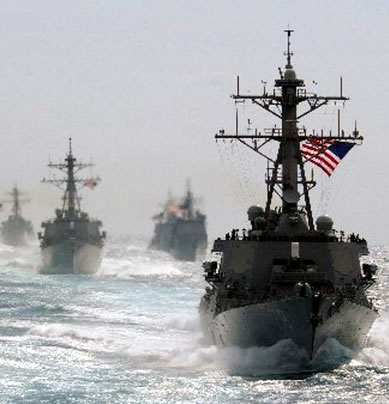
By Peter Apps
Sunday, October 24, 2010
 LONDON - In the Indian Ocean, international warships keep watch against Somali pirates, but in the long run, newly arrived forces from India, China, Russia and elsewhere may be as much rivals as allies.
LONDON - In the Indian Ocean, international warships keep watch against Somali pirates, but in the long run, newly arrived forces from India, China, Russia and elsewhere may be as much rivals as allies.
The U.S. Navy estimates that on any given day, as many as 40 warships are engaged in operations to keep shipping safe from young Somalis in skiffs with AK-47s and ladders.
Although U.S., NATO and European Union forces account for most of the buildup, China, Russia, India, Japan, South Korea and other nations have been increasing their presence in the past two years.
Piracy - which has redrawn shipping routes and driven up insurance costs - is the main driver, but participating nations are also seen as wanting to stake a claim to increasingly important sea lanes.
"These are still relatively smaller forces," said Christian la Miere, a naval expert at London's International Institute for Strategic Studies. "But if you're looking forward over the next few decades, there is no doubt Asian navies will have a larger presence in the Indian Ocean relative to Western forces."
The region is increasingly important. It accounts for 20 percent of global sea trade and a much higher proportion of energy and container shipments. It is the key shipping route for oil supplies from the Persian Gulf, for Chinese and Asian exports to Europe and for African resources, potentially food as well as minerals.
Besides fighting piracy, other agendas for Western forces could include keeping tabs on potential Iranian weapons-smuggling and monitoring militants in Somalia and Yemen. But for the emerging powers, the key interest is trade.
"The Indian Ocean is becoming a central sea lane," said Nikolas Gvosdev, a national security studies professor at the U.S. Naval War College. "China does not trust leaving this vital link in the hands of the U.S. Navy and wants to guarantee its access."
China's task force - three ships running convoys most days via the Yemeni city of Aden - is its first in the area since Admiral Zheng. He sailed in the 15th century.
Beijing's modern naval commanders have suggested opening regional bases to support anti-piracy operations as well as port projects in Pakistan, Sri Lanka and Burma.
That will alarm India, which has long regarded the ocean as its back yard. Like most Asian powers, India is building its naval forces just as Western navies cut back.
Russia's presence, usually a couple of ships, marks an increase in naval deployment outside its immediate region. Japan's force of ships and patrol aircraft is described by analysts as the first of its kind since World War II.
Admirals point to the deployment as a promising example of international cooperation. Although there is no one overall commander, international efforts are coordinated through monthly meetings and a secure Internet chat room.
Some complain that some of the emerging navies are too focused on safeguarding national shipping and could be used more effectively if coordination were better. Most emerging nations concentrate on escorting ships with their national flag, though India is particularly keen to stress that it has escorted vessels of all nationalities.
The warships have had some success disrupting attacks, but the number of pirates is still rising.
Overall, shippers say the naval buildup is good news. "This is about protection of the trade routes," said Peter Hinchcliffe, secretary general of the International Chamber of Shipping. "We absolutely welcome the naval cooperation. Navies that were, if not actually at war with each other, then definitely rivals, are working together and are comrades in arms."
But some see the rush of warships to the region - which largely began in 2008 after the hijacking of a Saudi oil tanker and a Ukrainian ship carrying military tanks - as partly fueled by a growing international rivalry.
"I don't think it necessarily has to be one or the other," said the Naval War College's Gvosdev. "It can be both."
Meanwhile, cannier governments around the region may use the focus on the Indian Ocean to their benefit. Chinese financial support was key to Sri Lanka's victory in its three-decade war with Tamil Tiger rebels after Western countries pulled back because of alleged human rights abuses. Now, to the concern of New Delhi, Beijing has helped fund a port at Hambantota, on the island's southern tip. Sri Lanka has emphasized its civilian nature.
For those concerned by rising international tensions over currencies, commodities and cyber-warfare, Indian Ocean rivalries could be another potential flash point.
"I do not want to join the dots on this, because I do not like the implications," said Michael Power, a global strategist for Anglo-South African Investec Asset Management.
Source: Reuters